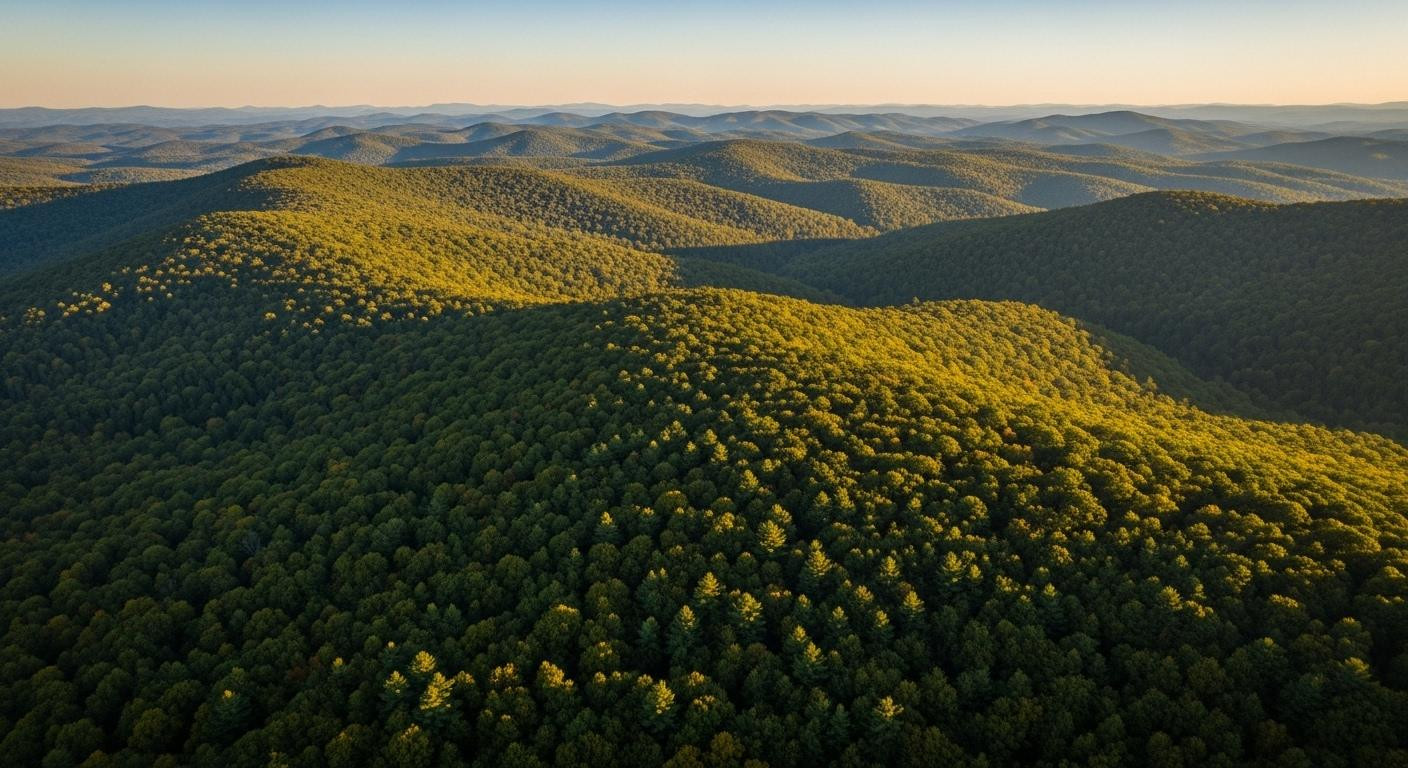Dawn mist rises from the forest floor as coffee steam mingles with pine-scented air. Just 95 miles from Times Square, 5,500 acres of wilderness education sanctuary spread across the Catskills. Most of New York’s 8 million residents have never heard of Frost Valley YMCA. This massive forest preserve operates quietly, transforming visitors through genuine nature immersion rather than Instagram-ready entertainment. For 140 years, families have discovered what happens when screens disappear and ancient hardwood forests take over.
Where 5,500 acres hide 2 hours from 8 million New Yorkers
The drive from Manhattan takes exactly 2 hours via I-87 and Route 42. Claryville appears suddenly after miles of forest. Population signs read fewer than 200 residents.
Frost Valley’s entrance at 2000 Frost Valley Road reveals the scale immediately. Forested ridges extend beyond sight lines. No cell towers interrupt the canopy.
The original 2,200-acre Forstmann family estate expanded to today’s 5,500 acres through careful land acquisition. This valley geography creates natural sanctuary boundaries. Rolling mountains shelter the property from urban sprawl creeping north from New York City.
What 140 years of forest education looks like before Instagram
Frost Valley began camp operations in 1885. The YMCA purchased the historic Forstmann Castle on Christmas Eve, 1956. That transaction included 40 rooms, 7 fireplaces, and a working dairy farm with 22 Holstein cattle.
The historic Castle and vernacular architecture
Cherry, butternut, and maple woodwork fills the Castle’s interior rooms. Teak and oak parquet floors transport visitors to a bygone era. The building anchors the camp’s educational mission rather than serving as tourist attraction.
Rustic camp buildings blend into the hardwood forest. Mongolian yurts and platform tents accommodate specialized programs. Architecture serves authentic educational purpose rather than Instagram aesthetics.
140 years of transformation infrastructure
Over 35,000 participants visit Frost Valley annually. Summer camps serve 4,000 children through traditional overnight programs. The facility operates year-round with adventure trips, survival camps, and environmental education.
As of August 24, 2025, Frost Valley became a nut-aware facility. This policy update reflects ongoing commitment to accessibility and safety. Four overnight camp sessions run from June through August 2026.
The experience between sunrise and campfire
Daily rhythms at Frost Valley follow natural light cycles. Dawn activities begin before tourists reach commercialized Catskills destinations. Evening campfires continue traditions unchanged for generations.
Wilderness activities beyond hiking
Environmental education programs utilize the Model Forest to teach watershed relationships. Archery and climbing walls integrate into forest settings rather than dominating landscapes. Horseback riding explores valley trails inaccessible by foot.
Adventure trips venture into deeper wilderness for backpacking and rock climbing. These valley experiences avoid crowded tourist destinations. Groups of 8 campers work with 2 staff members for personalized attention.
Catskills farm-to-table forest cuisine
Regional food traditions emphasize local game, trout, and maple products. Apple cider and homemade baked goods reflect Catskills heritage. Hearty mountain stews suit the climate and outdoor activities.
The Frost Valley Fall Fest celebrates regional artisans and food trucks during peak autumn colors. Traditional crafts and local food connect visitors to place rather than generic tourist experiences.
What changes when forest replaces screens
Recent visitor surveys describe profound transformation experiences. Families report genuine connection impossible in urban settings. The absence of cell service forces real conversation and natural observation.
One family reunion guest noted: “It was like having our own home in the country, very reasonably priced.” Another visitor described feeling “blissfully unplugged” with no internet, just good food and conversation. Educational testimonials emphasize ecosystem learning impossible in traditional classrooms.
This accessibility from America’s largest city creates unique opportunities. While commercialized resorts charge premium rates, Frost Valley’s educational mission maintains affordability through voluntary fee structures.
Your questions about Frost Valley answered
How do I actually get there from NYC?
Drive 2 hours via I-87 and Route 42 to Claryville. No direct public transportation exists. Train connections to Port Jervis or Kingston require additional local transport or rental car arrangements.
Car rental rates from NYC airports range $40-70 daily in 2025. Parking is available on-site. Most visitors drive due to limited public transit options to rural Catskills locations.
What does 140-year-old forest education cost?
Accommodation ranges from $70 rustic cabins to $250 luxury lodge rooms nightly. Frost Valley costs 10-20% below New York State averages for mountain resorts. Dining ranges $10-40 depending on meal complexity and location.
The voluntary four-tier fee structure keeps programs accessible to all families. All participants receive identical Frost Valley experiences regardless of payment tier selected.
When does the Catskills forest look best?
Fall foliage peaks mid-September through early November. Summer camp season (June-August) brings highest visitor numbers. Winter offers scenic snow landscapes but limited outdoor programming.
Shoulder seasons provide solitude and lower costs. Spring emergence creates different beauty as forest awakens from winter dormancy. Autumn combines perfect weather with spectacular color transformation.
Evening campfire smoke rises through autumn canopy as darkness settles over 5,500 acres. The profound silence of deep forest wraps around rustic cabins. This wilderness sanctuary exists just beyond the city’s reach.
